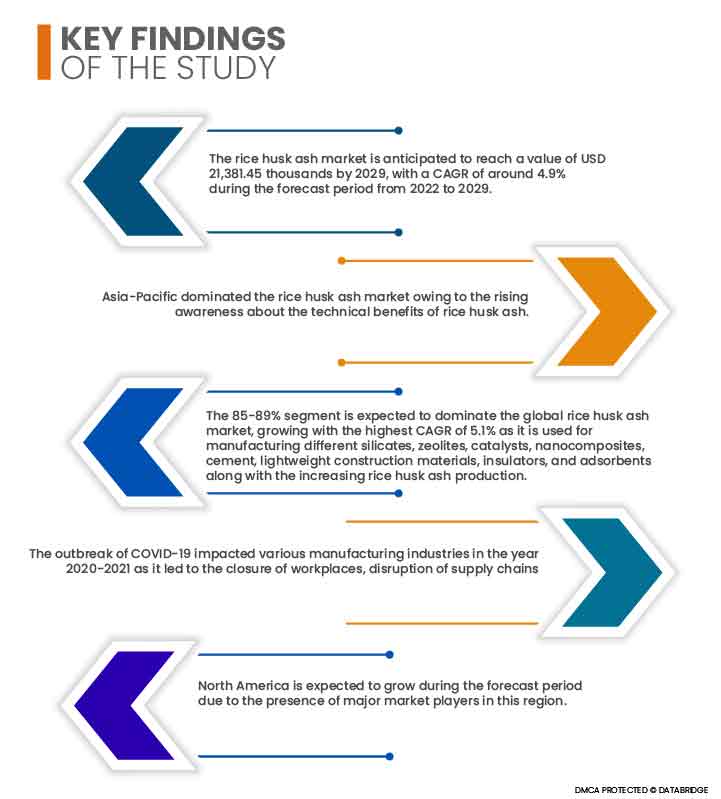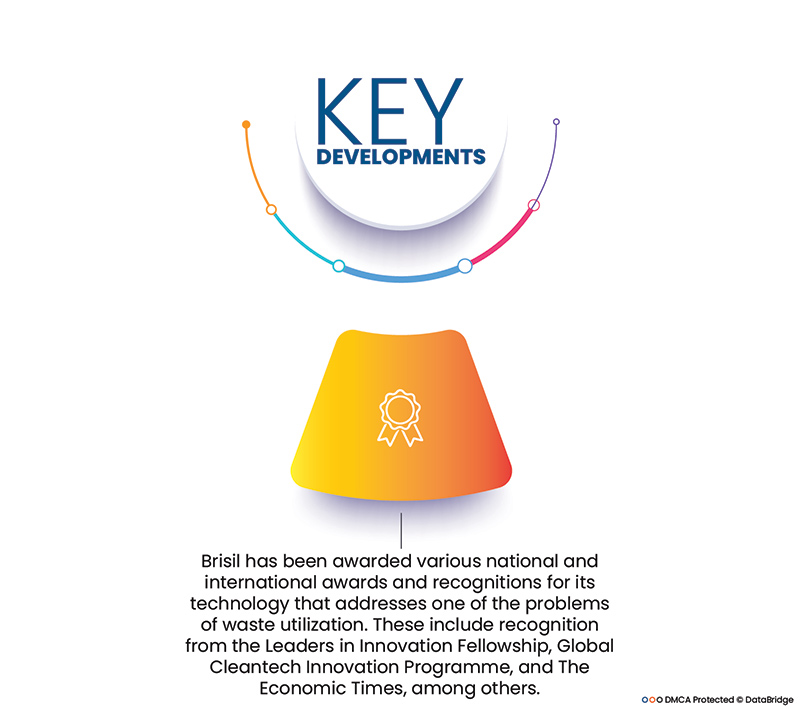Rice husk ash is widely popular for its various properties and benefits, such as fine insulating properties with high melting point and porosity, low thermal conductivity, and bulk density. These properties make it an ideal material for use in various industries and segments. Therefore, the global rice husk ash market is estimated to increase rapidly in the near future.
Access Full Report @ https://www.databridgemarketresearch.com/jp/reports/global-rice-husk-ash-market
Data Bridge Market Research analyses that the rice husk ash market is expected to grow at a CAGR of 4.9% in the forecast period of 2022 to 2029 and is expected to reach USD 21,381.45 thousands by 2029. The global rice husk ash market is expanding rapidly due to the increasing use of rice husk ash in producing high-quality silica. Compared to other silica sources such as sand, bentonite, and diatomaceous earth, rice husk has tiny amounts of contaminants that barely affect performance in applications requiring high purity, such as in the manufacture of solar panels requires highly purified silica. Therefore, rice husk is an important source of silica.

Growing Demand Owing To Adherence to Environmental Regulatory Norms is expected to drive the Market's Growth Rate
Rice husk ash has been gaining popularity among various industries and consumers as they are regulated by various regulatory bodies and permitted for use. For instance, In Europe, European Chemicals Agency (ECHA), in its REACH regulation No.: 275-735-5, has permitted the use of substance obtained by burning the husk removed from the rice paddy. These may contain silica and elements such as aluminum, calcium, carbon, chromium, copper, indium, iron, lead, magnesium, manganese, molybdenum, phosphorus, silver, sodium, tin, and zinc. There have been regulations in other countries regarding the use of rice husk ash and its components. The rice husk ash is gaining popularity and getting approval from regulatory bodies due to its favorable soil effects in terms of acidity correction. Therefore, the adherence to rice husk ash for various other purposes is expected to provide lucrative opportunities for growth in the global rice husk ash market.
Report Scope and Market Segmentation
|
Report Metric
|
Details
|
|
Forecast Period
|
2022 to 2029
|
|
Base Year
|
2021
|
|
Historic Years
|
2020 (Customizable to 2014 - 2019)
|
|
Quantitative Units
|
Revenue in USD Million, Volumes in Units, Pricing in USD
|
|
Segments Covered
|
By Form (Pallets, Powder, Flake, Nodule/Granules), Silicon Content (80-84%, 85-89%, 90-94%, More Than 95%), Downstream Application (Concrete Mixes, Building Blocks, Refractory Bricks, Metal Sheets, Roofing Shingles, Insulators, Water Proofing Chemicals, Pesticides, Others)
|
|
Countries Covered
|
U.S., Canada, Mexico, Germany, Sweden, Poland, Denmark, Italy, U.K., France, Spain, Netherlands, Belgium, Switzerland, Turkey, Russia, Rest of Europe, Japan, China, India, South Korea, New Zealand, Vietnam, Australia, Singapore, Malaysia, Thailand, Indonesia, Philippines, Rest of Asia-Pacific, Brazil, Argentina, Rest of South America, UAE, Saudi Arabia, Oman, Qatar, Kuwait, South Africa, Rest of Middle East and Africa
|
|
Market Players Covered
|
Astrra Chemicals (India), Global Recycling (Czech Republic), K V Metachem (India), Brisi (India)l, The Agrilectric Companies (U.S.), Rice Husk Ash (Thailand), Guru Corporation (U.S.), JASORIYA RICE MILL (India), and PIONEER Carbon (India)
|
|
Data Points Covered in Report
|
In addition to the market insights such as market value, growth rate, market segments, geographical coverage, market players, and market scenario, the market report curated by the Data Bridge Market Research team includes in-depth expert analysis, import/export analysis, pricing analysis, production consumption analysis, patent analysis and consumer behaviour.
|
Segment Analysis:
The global rice husk ash market is segmented into three notable segments based on form, silicon content, and downstream application.
- On the basis of form, the global rice husk ash is segmented into pallets, powder, flake, and nodule/granules. In 2022, the pallets segment is expected to dominate the global rice husk ash market, growing with the highest CAGR of 5.3% in the forecast period of 2022 to 2029. The pallets segment is expected to dominate the global rice husk ash market because they are small-sized, highly dense, and compacted, making them easy to store and transport. In addition, they have been proven much more effective as wood fuel. Moreover, the growing rice husk ash pallets in the fuel industry as well as different industries, such as the steel and metal industries.
- On the basis of silicon content, the global rice husk ash market is segmented into 85-89%, 90-94%, more than 95%, and 80-84%. In 2022, the 85-89% segment is expected to dominate the global rice husk ash market, growing with the highest CAGR of 5.1%
The 85-89% segment is expected to dominate the global rice husk ash market
In 2022, the 85-89% segment is expected to dominate the global rice husk ash market, growing with the highest CAGR of 5.1% in the forecast period of 2022 to 2029. The 85-89% segment is expected to dominate the global rice husk ash market because this rice husk ash is used for manufacturing different silicates, zeolites, catalysts, nanocomposites, cement, lightweight construction materials, insulators, and adsorbents along with the increasing rice husk ash production. Moreover, due to increasing this rice husk ash used in waterproofing chemicals and insulators and the high demand for 85-89% silica content in different industries such as tire and fertilizer industries further boost the market demand globally.
- On the basis of downstream application, the global rice husk ash market is segmented into concrete mixes, building blocks, refractory bricks, metal sheets, roofing shingles, insulators, water proofing chemicals, pesticides, and others. In 2022, the concrete mixes segment is expected to dominate the global rice husk ash market, growing with the highest CAGR of 5.4% in the forecast period of 2022 to 2029. The concrete mixes segment is expected to dominate the global rice husk ash market because rice husk ash provides good compressive strength to the concrete, and as it is a by-product, it helps in cutting down the environmental pollution coupled with growing construction activities. Moreover, the high silica content makes it a good supplementary cementitious material or pozzolanic admixture for concrete mixes and silica content makes the concreate mixer the best support without being expensive in the construction industry. Also, due to growing concern for cutting down environmental pollution by using rice husk ash in the construction industry because the use of rice husk ash in concrete is a much more sustainable solution than using conventional raw materials such as Portland cement. Its characteristics provide strength to the construction material and boost its growth globally.
Major Players
Data Bridge Market Research recognizes the following companies as the major rice husk ash market players in rice husk ash market are Astrra Chemicals (India), Global Recycling (Czech Republic), K V Metachem (India), Brisi (India)l, The Agrilectric Companies (U.S.), Rice Husk Ash (Thailand), Guru Corporation (U.S.), JASORIYA RICE MILL (India), and PIONEER Carbon (India)

Market Development
- Brisil has been awarded various national and international awards and recognitions for its technology that addresses one of the problems of waste utilization. These include recognition from the Leaders in Innovation Fellowship, Global Cleantech Innovation Programme, and The Economic Times, among others
Regional Analysis
Geographically, the countries covered in the rice husk ash market report are U.S., Canada, Mexico in North America, Germany, Sweden, Poland, Denmark, Italy, U.K., France, Spain, Netherlands, Belgium, Switzerland, Turkey, Russia, Rest of Europe in Europe, Japan, China, India, South Korea, New Zealand, Vietnam, Australia, Singapore, Malaysia, Thailand, Indonesia, Philippines, Rest of Asia-Pacific (APAC) in Asia-Pacific (APAC), Brazil, Argentina, Rest of South America as a part of South America, UAE, Saudi Arabia, Oman, Qatar, Kuwait, South Africa, Rest of Middle East and Africa(MEA) as a part of Middle East and Africa(MEA).
As per Data Bridge Market Research analysis:
Asia-Pacific is the dominant region in rice husk ash market during the forecast period
Asia-Pacific dominated the rice husk ash market owing to the rising awareness about the technical benefits of rice husk ash. Asia-Pacific will continue to dominate the rice husk ash market in terms of market share and market revenue and will continue to flourish its dominance during the forecast period. This is due to the increasing demand for silica from various end-use industries in this region.
North America is estimated to be the fastest-growing region in rice husk ash market
North America is expected to grow during the forecast period due to the presence of major market players in this region. In addition to this, e growth of the construction and steel industries is expected propel the market's growth rate in this region.
COVID-19 Impact Analysis
The outbreak of COVID-19 impacted various manufacturing industries in the year 2020-2021 as it led to the closure of workplaces, disruption of supply chains, and restrictions on transportation. However, a significant impact was noticed on rice husk ash in the global operations and supply chain, with multiple manufacturing facilities still operating. The service providers continued offering rice husk ash following sanitation and safety measures in the post-COVID scenario.
For more detailed information about the rice husk ash market report, click here – https://www.databridgemarketresearch.com/jp/reports/global-rice-husk-ash-market













